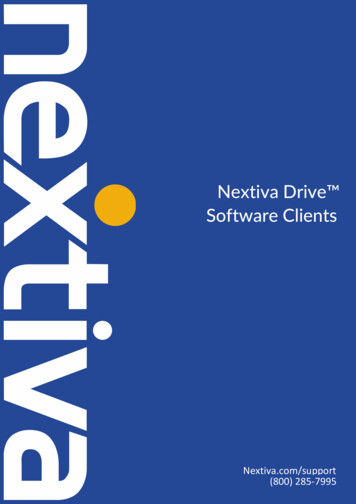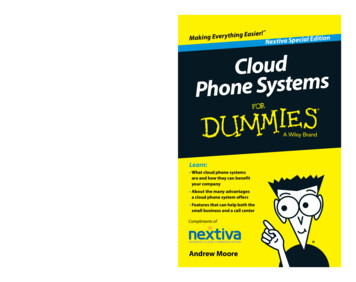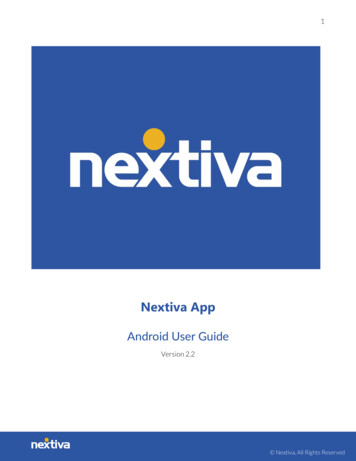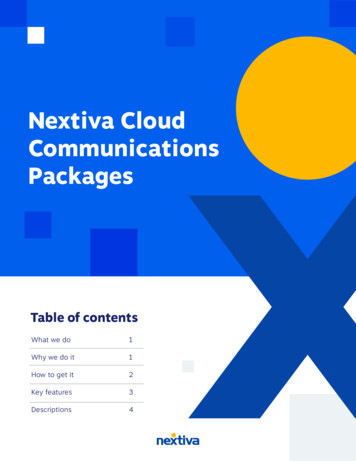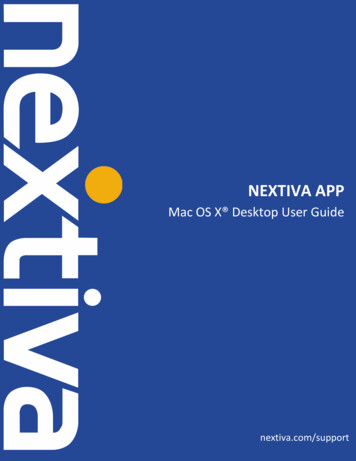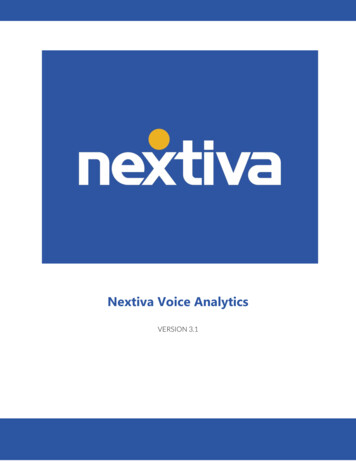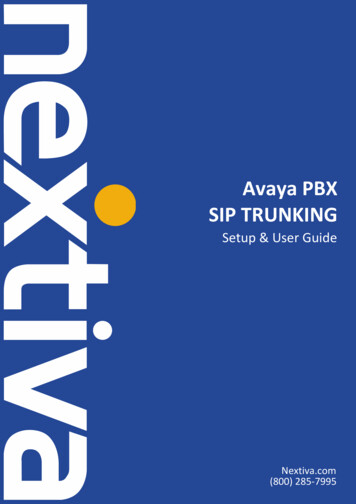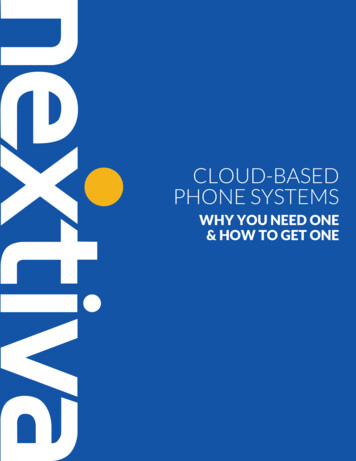
Transcription
CLOUD-BASEDPHONE SYSTEMSWHY YOU NEED ONE& HOW TO GET ONE
Cloud-Based Phone SystemsCloud-based phone systems are growing more and more popular. Simply put, cloud-based phone systems aresoftware-based phone systems that store and transfer voice and data on a server that is accessed via the Internet. Assuch, these systems do not require on-premise hardware or equipment. Additionally, these phone systems are able tofit users with standard functions—the ability to deliver calls over the Internet, route inbound calls correctly, etc.—aswell as include extensive VoIP features such as call recording, voice mail transcription, virtual numbers and more.In a cloud-based system, the term “system” best refers to one of two things: a series of interconnections that enable asingle phone to work over the Internet, or a group of devices (here, being phones) that work together. Typically, itrefers to the latter. Additionally, the cloud refers to a virtual (or digital) space where data can be stored, transferred,accessed, and/or otherwise managed.In utilizing a digital space, cloud-based phone systems offer a number of advantages spanning increased costefficiency, better employee management, more thorough system monitoring, and much more. As a result, manycompanies have already utilized the cloud to offer consumers management and storage services (i.e. Google Drive,Dropbox, SugarSync, etc.). Seeing how this has been widely adopted, the cloud has since been fitted for otherapplications and platforms, namely phone systems.Advantages over Public Switched Telephone Network (PSTN):Cost Efficiency: Users can greatly diminish their management, maintenance, service, repair, operations, labor, andupfront costs. Cloud-based systems operate using a third party provider’s equipment and hardware; therefore, usersare not responsible for the equipment running their phone system. Users, more or less, rent providers’ equipment, asopposed to other systems where hardware is purchased and managed. It is the provider’s responsibility to maintain,upgrade, manage, and repair the system. As a result, businesses are better able to utilize their staff within thebusiness itself as opposed to their system’s infrastructure—i.e. no need for IT staff.Service and operation costs are greatly reduced as well. First off, there are no purchasing costs. While there may stillbe some upfront cost (i.e. handsets, gateways), they’ll be significantly less. Users pay for a third party provider’sservice via pricing plan—which can be a monthly charge or a contract. As such, these pricing plans denote thespecifications and amenities of the service. For example, Nextiva is a provider that offers a number of servicesincluding Business VoIP, Call Center plans, SIP Trunking, and vFAX. In each of these services, the provider offers avariety of plan options—each offering different features and pricing. Call Center plans, for example, are divided by“Pro” and “Enterprise” options. Both offer office features and functions designed to fit different users’ needs. Thisvariety helps businesses to better know the capability of the system, as well as budget accordingly.Advanced Features: As stated above, cloud-based phone systems come with a host of advanced features that allowfor a number of different functions. These features span system configuration and management, voice and fax toemail, call answering, call centers & call queuing, call routing, conferencing, user experience, and more.
Cloud-Based Phone SystemsAccessibility & Ease of Use: Cloud-based services are hosted by a third party provider; therefore, users are free fromthe technical complexities of an on-premise solution. Users do not deal with the technical aspect of the system - theprovider does. This allows users to focus on navigating and utilizing the actual system. Additionally, as the service ishosted by a third party provider, it’s likely that users will be privy to various modes of customer support—i.e. techsupport and information resources.Time Efficiency: Unlike other services, cloud-based solutions do not require a lot of setup time. In fact, they aretypically up and running in a few days, if not hours or even minutes. Aside from setup, these systems also allot forgreater ease of use and accessibility; therefore, employees are able to better utilize and navigate the system resultingin quicker response time and greater productivity. Separate from accessibility, cloud telephony incorporates anumber of features and functions that can be used to expedite processes. For example, there are a number ofautomations that can delineate incoming calls through the proper channels.Image: Cloud-based phone systems include a number of VoIP features that allow for the better management ofbusinesses’ phone systems. As such, businesses of any size can emit a higher degree of professionalism and credibility.For example, providers such as 8x8, RingCentral, and Nextiva are able to cater to both small and large businesses. Forexample, RingCentral Office is available for 2-19 users, 20-99 users, or 100 users. Similarly, Nextiva offers plansthat range from 1 to 100 lines for their system.Customization: Cloud telephony providers typically allot for customizations through service plan options, features,and quotes. First off, service plans dictate different features, included minutes and locations, and different pricing;therefore, users are able to find a system that best fits their individual needs. Secondly, in offering add-on features ala carte, users are able to alter/reshape their system for their business. Lastly, with individual quotes, users work withproviders to build a custom solution (in price and features) to best suit their needs. Nextiva’s Office solution includesall of these options.Nextiva offers users two primary plans, Office Pro and Office Enterprise. Both services include a number of thesame features; however, the Enterprise option is more extensive, offering features exclusive to the upgraded plan(i.e. a toolbar, hoteling host, remote office, and more). Aside from plans, the provider also offers Office upgrades,which are a la carte add-on features that can be implemented and/or changed. Users are also able to designate thenumber of intended users as line tiers range from 1-4, 5-20, and 21 . Lastly, if users still cannot find the right option,they can request custom service quotes directly from the provider.Mobility/Flexibility: Cloud telephony enables users to access their business phone system from different locationsand various devices. As opposed to other phone connections, cloud services are not tied to a desk and can be easilyhooked up with mobile devices; therefore, users can utilize a number of different practices to maximize their staff,allow for greater cost and time efficiency, and increase productivity. For example, businesses can deploy mobileemployees, restructure their office’s infrastructure, as well as allow users to utilize existing data connections to saveon local and long distance charges.
Cloud-Based Phone SystemsMaximize Your Return on the Phone System You ChooseDespite the various advantages that come along with cloud telephony, some users may still be hesitant to switch.While this could stem from a number of different anxieties, the most common is finance. While there is a lot ofpotential for gaining cost efficiency, cloud-based systems also have a greater capacity for a more beneficial return oninvestment (ROI) for users. ROI refers to an investment (here being a cloud-based phone system) yielding a benefit(here being any of the above) for its user(s). In utilizing a number of features and advantages, users who switch tocloud-based systems are likely to experience a quicker and more expansive ROI—i.e. greater cash efficiency, timeefficiency, increased usability, and, ultimately, productivity.Typically, ROI is calculated by the formula “expected benefit” divided by the cost. While this has been effective before,users should also consider other factors to determine their actual ROI. For example, some applications may need tobe redesigned or reconfigured to properly work within the cloud environment; therefore, users should weigh theamount of work necessary against the amount of time required, as well as how much it would subsequently cost to dothis. Scalability and flexibility weigh into the ROI equation, too. Users usually pay for what they use—i.e. differentpricing plans/tiers. As such, users can view their system analytics to scale their system accordingly—i.e. add or dropcertain features based on usage. In doing so, users can better manage their monthly cost of service.All variables aside, cloud-based phone systems have the potential to provide users with a quicker and morecomprehensive return. In regards to costs, businesses save as the platform does not start up, operational, equipment,managing, and repair costs. Additionally, in regards to productivity, the platform includes a number of functions andfeatures designed to better utilize employees Although the cloud platform has the potential for greater ROI, it’scrucial for users to consider and weigh all factors.How to Improve Productivity by SwitchingThe most effective way in which productivity can be boosted within a cloud-based phone system is through betterutilization of both the system and the staff. Luckily, cloud-based systems offer a variety of different functions andfeatures that ultimately allow for greater productivity amongst staff.Familiarity: Knowing and understanding the system is much easier with a cloud-based solution as users need notworry about the technical aspect. Instead, they can focus on the workings of the actual system. This can greatlyaugment users’ productivity. By understanding how to navigate through one’s system, users are better able toperform tasks quickly and efficiently. For example, users can utilize auto attendants (or virtual receptionist) to helpsteer callers towards the department or employee best suited to take the call, as opposed to a live operatortransferring/routing calls.
Cloud-Based Phone SystemsPortability/Mobility: By allowing users to access the system anytime, anywhere, and from any device, employees areable to stay much more interconnected with one another, as well as the business. This interconnectivity not onlyallows current staff to be more effective, but it can boost a business’s range of employees. For example, by utilizingmobile function, businesses are able to expand their workforce internationally to provide continuous customerservice without having to pay extra for overtime, business office charges, etc.Scalability: Scalability stems from familiarity—i.e. the better a user knows their system, the more they are able todetermine what it needs to better function. Additionally, both mobility and integration allow businesses to expandtheir system according to their needs. In doing this, businesses may benefit from easier management and costefficiency. All expansion is done virtually; therefore, there are no equipment costs. As such, businesses are better ableto offer expansive service and grow to meet new demands without having to manually expand their systems.Additionally, to help aid in scalability, many providers’ plan tiers are optioned based on the number of needed lines.For example, Nextiva’s Office solutions are designated by “Pro” and “Enterprise”—each denoting different functions.In addition to this, the provider offers both plans for different intended numbers of users—i.e. 1-4 lines, 5-20 lines,21 lines. In doing so, businesses are better able to select a service plan that both includes all necessary features(denoted by Pro or Enterprise) and fits the size of staff.Lower Operational Costs: Cloud telephony allows users to cut out equipment and hardware costs, as well asupgrades, management, and maintenance costs. In doing so, businesses are able to better utilize funds where they areneeded more. For example, money saved from operational costs can be used to expand staff where needed—i.e.customer service, mobile employees, sales representatives, etc.Integration: Again, not all applications are suited for cloudenvironment; therefore, some may need to be redesigned or refit.Though this may take more time and resources initially, it is likely tobenefit users in the long run. By integrating certain applications, usersexpand the functionality of their system. As a result, users may bebetter able to delegate tasks through automations and employees.Some providers will include integration capabilities within theirsystems. For example, 8x8’s Virtual Office solution includesintegrations for Salesforce.com, Outlook, NetSuite, and more. Withthese integrations, users are able to utilize their cloud-based phoneservice directly within the selected platform. This level ofconsolidation allows for much greater efficiency.
Cloud-Based Phone SystemsHow to Get the Best Deal & Find the Best ProviderDefining one’s needs is paramount. More often than not, providers use pricing and service features as a way todistinguish service plans from one another, as well as distinguish themselves from competition; therefore, it’simportant for consumers to know what they’re looking for. In knowing the features and functions needed, along withthe available budget, number of users, and intended system uses, it’ll be much easier to select a provider.In determining one’s needs, it’s crucial to survey the landscape—i.e. see what’s out there. Research is a necessity bothbefore and after determining a system’s needs. That being said, consumers should search through various webreviews, user reviews, white papers, testimonials, forums, blogs, etc. to find as much useful information as possible.Collectively, these tools are helpful in creating a well-rounded picture of the provider and their service; however,individually, they are less effective. For example, user reviews do not represent a comprehensive portrait of service.Instead, it captures one user’s experiences. While this could be useful juxtaposed other informative sources, it is nothelpful on its own.Defining one’s needs not only helps users find the best service provider functionality-wise, but price-wise as well.Service plans are typically priced according to function (i.e. unlimited plans, metered plans, international plans, etc.),included features (auto attendant, call blocking, caller ID, etc.), and the intended number of users/lines. Providers arelikely going to offer more than one service/product. Nextiva, for example, offers Office solutions, SIP Trunking,Contact Center solutions, and more. There are different plans within these offerings that denote different needs. Forexample, Nextiva Connect is a virtual phone system that allows users to route calls anywhere at any time. Whilefeatures are universal for this service, plans are differentiated by included minutes (100, 500, or unlimited). Theseplans are also different in pricing; therefore, users should determine if they need this service, how often they’ll need it,how many users will need it, and the most cost efficient route.Though defining your needs is paramount, your decision is ultimatelyAnother good example can be seen withhinged on research. Users need to research providers even afterNextiva and their customer relationshipthey’ve determined what they’re looking for, because there are a lot ofmanagement (CRM) integration. A CRMservices and providers available. Users need to carefully analyze theis a program that compiles customerpros and cons of each in order to narrow down a viable option. Researchinformation and allows users to access it.can also help leverage pricing with providers. Many providers offer a laNextiva’s NextOS platform can connectcarte pricing to allow for businesses to better customize solutions. Inwith most CRM software. In doing so,researching custom options, users may be able to build a more costbusinesses can fit their systems withefficient solution that providers officially offer.expansive customer information thatusers can easily access.
Cloud-Based Phone SystemsStatisticsThough there are a number of advantages to be had in switching to cloud-based phone system, many users are stillhesitant to switch. While these anxieties stem from different fears, it doesn’t seem that they will ultimately affect thecloud industry. According to CloudNOW, a non-profit global cloud computing think tank, the cloud will continue togrow despite users’ concerns. Additionally, Gartner, a global technology research company, recently reported thatbetween 2013 and 2016 677 billion will be spent on cloud services worldwide. That being said, it seems that even infacing hesitancy, cloud applications are being projected to face a lot of growth.Though cloud applications’ growth can be due to a number of reasons,recent studies show that it is largely due to personal use of the cloud.According to CDW’s 2013 State of the Cloud Report, 66% of ITexperts claim that their recommendations for cloud adoption arebased off of personal usage. Additionally, 73% of cloud users and 58%of non-cloud users indicated their personal use has influenced theirrecommendation.CDW State of the Cloud: What Drives Cloud Adoption?With various projections all indicating continued growth, many companies are now expanding their cloud offeringsinto new territories, resulting in rising budgets in support of cloud adoption. Gartner supports this estimating 60% ofNorth American IT industry execs will increase their software-as-a-service and public cloud budgets between 2013and 2014.Regardless of whatever reservations users may have, cloud adoptionlargely looks to be on the rise. That being said, now may be the besttime to adopt a cloud-based phone system. As trends continue toclimb, interest is likely to churn new innovations and applications;therefore, users stand to gain a lot.Gartner Numbers Cloud Computing Forecast
Cloud-Based Phone SystemsQuestions to Ask a Potential ProviderWill I Get the Features I Need? After defining your essential needs, be sure that the provider can account for them.For example, compile a list of essential features. Run down the list with the provider to be sure they are included withtheir service.What equipment will I need? Though cloud-based phone systems require very little hardware (typically justhandsets), users should be sure there is no need for anything else. For example, some providers allow users to usetraditional phones with an ATA adapter—which is sometimes subject to additional cost.What is your system’s uptime? Uptime refers to the amount of time a provider’s service is up and available over thecourse of a year. Users want to be sure there system is available to them as much as possible; therefore, one shouldalways ask about the amount of unexpected downtime is experienced.What support is included? What types of redundancies are in place? In the same vein as uptime, users want to besure that if they run into a problem with their system, the provider offers readily available support. Additionally, in theevent of power outages, natural disasters, or other circumstances, users’ systems may go down. Users want to besure that their system is back up and running ASAP, and that it is unaffected. As such, users should ask providers thesteps they take to reduce outages, as well as restore service in the event of a system failure.What monthly charges will I be subject to? Though service is usually charged either yearly or monthly, users shouldinquire about additional fees—i.e. equipment leasing, add-on features, installation fees, activation fees, etc.How do you guarantee quality? Again, support and redundancy are important; however, so is quality assurance.Users should ask providers how they ensure the utmost quality at all times.How do I know you’ll stay in business? Currently, consolidation and acquisition are very popular amongst providers;therefore, users want to be sure their providers will be around for the long haul. Additionally, if you enter into acontract, and the provider then goes under, you want to be sure your contract is binding—i.e. you still receive sameservice for same pricing. Users should use these questions as a guideline when talking to a potential provider;however, that doesn’t mean this is all that they should ask. It is important to find out everything you can about aprovider and their service.
Cloud-Based Phone Systems Cloud-based phone systems are growing more and more popular. Simply put, cloud-based phone systems are software-based phone systems that store and transfer voice and data on a server that is accessed via the Internet. As such, these systems do not require on-premise hardware or equipment.
